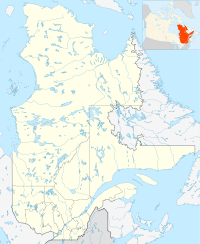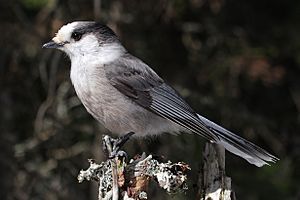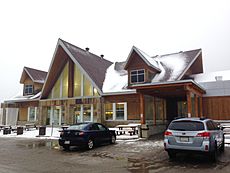Laurentides Wildlife Reserve facts for kids
Quick facts for kids Réserve faunique des laurentides |
|
|---|---|
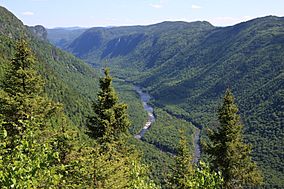
View of the Jacques-Cartier River valley
|
|
| Location | Canada, Quebec |
| Nearest city | Quebec City, Saguenay, Quebec, Charlevoix Regional County Municipality La Côte-de-Beaupré Regional County Municipality La Jacques-Cartier Regional County Municipality La Tuque Le Fjord-du-Saguenay Regional County Municipality Lac-Saint-Jean-Est Regional County Municipality |
| Area | 7861 km² |
| Established | 1895 |
| Governing body | Sépaq |
The Réserve faunique des Laurentides is a huge natural area in Quebec, Canada. It's also known by its old name, Parc des Laurentides. This special place is a wildlife reserve. It sits between Quebec City and the Saguenay–Lac-Saint-Jean region.
The reserve is part of a network of wildlife reserves in Quebec. It is looked after by the Ministry of Energy and Natural Resources (Quebec) and the Société des établissements de plein air du Québec (Sépaq). The reserve covers about 7,861 square kilometers. It has over 2,000 lakes and many mountains taller than 1,000 meters. People who love the outdoors enjoy coming here for hunting and fishing.
Contents
History of the Reserve
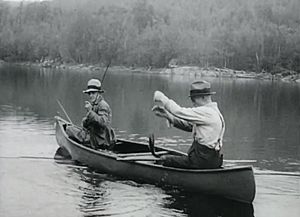
The Parc des Laurentides was first created in 1895. It was set up to protect forests and offer a place for people to enjoy nature. Later, in 1981, two big parts of the park were separated. These became Jacques-Cartier National Park to the south and Grands-Jardins National Park to the east. The rest of the land became the wildlife reserve we know today.
The first path through this area was called the Jesuit trail. It was cleared in 1676. This trail connected Quebec City to Lac Saint-Jean and took about three days to travel. It followed rivers like the Jacques-Cartier River and the Pikauba River.
A more usable road, called the "road of Quebec," was built in 1881. It allowed people to travel from Hébertville to Lac Saint-Jean in about 40 hours. A branch of this road was added in 1882, leading to Chicoutimi.
In the 1940s, a new road was planned and built. This road, Route 175, opened in 1948. For a long time, there were gates at the entrances to the reserve along this road. These gates were used to check who was coming and going. They were removed in 1977.
At the center of Route 175, there was a rest area called L'Étape. It was located by Jacques-Cartier Lake. There was also a station for the Sûreté du Québec (Provincial Police) there. After a fire, these buildings were taken down in 2005. Today, L'Étape has a restaurant, a special rescue unit, and an ambulance station.
In 1952, a radar station was built at Mont Apica inside the reserve. This station was part of a defense system for North America. It was used to watch for planes from the Soviet Union. The radar station closed in 1993.
Different groups of Indigenous people, like the Hurons-Wendat and the Montagnais of Mashteuiatsh, have traditionally hunted moose in this area. Sometimes, they had disagreements about these hunting practices.
Geography of the Reserve
The Réserve faunique des Laurentides is located in the Laurentian Mountains. It is part of a mountain range called the Jacques-Cartier Massif. The land is very mountainous, and its highest point is Mount Belle Fontaine, which is 1,151 meters tall.
This large wildlife reserve, covering 7,861 square kilometers, stretches across three regions of Quebec: Capitale-Nationale, Saguenay–Lac-Saint-Jean, and Mauricie. It shares its borders with several other protected areas. These include zec Mars-Moulin to the northeast and Jacques-Cartier National Park to the south.
Inside the reserve, there are also two smaller, very protected areas called ecological reserves. These are the Thomas-Fortin and Victor-A.-Huard reserves. A part of the eastern side of the reserve is also part of the Charlevoix Biosphere Reserve.
Natural Heritage
The Réserve faunique des Laurentides is a home for many different plants and animals. It is part of the boreal forest region.
Vegetation: Plants and Trees
The main trees you will find here are firs, spruces, and white birches. The types of trees change depending on how high up you are. At lower altitudes, you'll see balsam firs and yellow birches. Higher up, especially on dry mountain tops, you might find black spruce trees.
Fauna: Animals of the Reserve
Many different kinds of insects, mammals, birds, and fish live in the Réserve faunique des Laurentides.
Insects
- Polygon with green spots (Polygonia faunus)
- Histeridae (Mylabris quadripunctata)
Mammals
- Caribous (they were brought back to the area in the 1960s and 70s)
- Castors
- Cougars (people are seeing more of them in certain spots)
- Hares from America
- Wolves
- Lynx
- American martens
- Mooses
- Black bears
- Porcupines
- Foxes
Birds
Pisces: Fish
Activities and Facilities
In the middle of the Réserve faunique des Laurentides, you'll find L'Étape. This is a busy rest area located on the shores of Jacques-Cartier Lake. Here, you can get food and refuel your vehicle. It's the only stop between Stoneham and Hébertville (near Lac Saint-Jean) or Saguenay.
Close by, there is a rescue patrol station with special tools to help with accidents. There is also an ambulance station. You can also find the La Loutre reception center, which has cabins and places to camp.
Further south, at kilometer 94, is the Camp Mercier reception center. It has 19 cabins for visitors.
You can enjoy many activities here depending on the season. These include fishing, hunting for small and large animals, cross-country skiing, snowshoeing, and snowmobiling. Snowmobiling is allowed only on the special provincial snowmobile trail.
Access to the Reserve
The reserve is often called "the park" by people who live nearby. It is divided in half by Route 175. This road connects Quebec and Saguenay. Another road, Route 169, leads to Hebertville. This is a main entrance to the Lac Saint-Jean area.
Route 175 is also known as Boulevard Talbot. It was named after Antonio Talbot, a politician who was a Minister of Roads. This road crosses the wildlife reserve. It used to have one or two lanes in each direction, depending on the part of the road.
Big construction work on Route 175 started in 2006 and finished in 2012. Now, the road has two lanes in each direction, making travel easier.
The year 2020 was the 125th anniversary of the Laurentides Wildlife Reserve. To celebrate, a historian named Marc Vallières published a book about its history.


